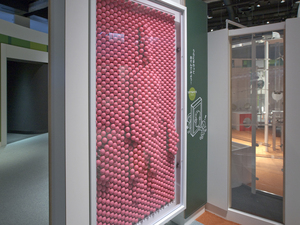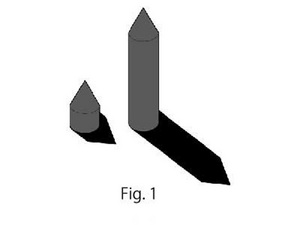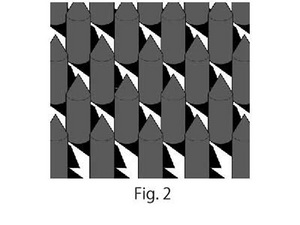Nagoya City Science Museum
TOP > Exhibition Guide > Floor Map> Pinscreen
Pinscreen



Purpose of Exhibition
After flattening the screen by the lever, try pressing your limbs or body against this screen. The pressed part of the screen become concave, and protrudes into the back of the screen.
In this exhibit, a variety of shapes can be made.
Additional Knowledge
[Pinscreen]
The basic idea of this exhibit is called "Pinscreen". It was created by a Russia-born filmmaker named Alexander Alexeieff in the 1930s as a tool for creating animation. In this exhibition, balls are used, but originally, pin screens use a myriad of small pins. It is stuck on a white screen vertically. When a strong light source hits the screen from the side, at the points where pins protrude, shadow is generated and looks black. You can avoid shadow generation by pushing the pin back in the opposite side, and it appears white again (Figure 1). By controlling the state of protrusion of the pin, you can apply shade to draw black and white pictures (Figure 2).
Alexeieff and his colleagues created animation by photographing pictures frame by frame drawn on a pinscreen. Pictures drawn on a pinscreen have a distinct atmosphere. Basically, it takes a lot of time to handle pictures only drawn in black and white, therefore, there are not very many artists using it.
[Pinscreen and Digital]
The balls used in this exhibition are big compared to pins; therefore, a detailed representation is not possible. For example in the case of an adult hand, the shape of the hand could be represented. However, in the case of a small child's hand, only a few balls will move and a clear shape couldn't be represented. This is the same as the difference of the number of pixels when taking pictures with a digital camera. If the screen is the same size, and you use big balls, the total number of balls lining on the screen is small.
Conversely, when you use small balls, the total number of balls is large.
The smaller the ball is, the greater the number is. Therefore the larger the number of pixels, the more detailed shape can be represented.
In the case of photos, they become clear and beautiful pictures.
There are exhibits about the number of pixels of digital cameras at the corner of the information and science section on the 4th floor of the Science and Technology Hall. We recommend you check it out.
ReferencesNational Film Board of Canadahttp://www3.nfb.ca/animation/objanim/en/techniques/pinscreen.php Article and illustration by Tetsuro Ojio, curator
